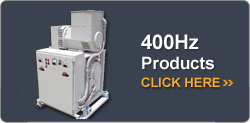Electronic / Static Frequency Converter Overview
Electronic or Static frequency converters make the conversion of your facility 60 Hertz utility power line using rectification changing the AC utility power line to a Direct Current voltage level, then using this DC level with semiconductor switching technology to make the new frequency and voltage levels.
Output Voltage Regulation
The Electronic frequency converter output voltage is regulated by solid-state voltage regulator(s) that continuously samples the output phase voltage and makes the needed control adjustment in order to maintain output voltage to within specifications. Typical output voltage regulation is +/-1% or less during 0% to 100% steady state load conditions.
Electronic frequency converter output voltage can be adjusted by the user over a range of approximately +/-10% of nominal (wider range on most models), and is facilitated by a Volts Adjust control(s) located at the operator control panel.
Electronic Frequency Converter Output Frequency Regulation
The output frequency of the electronic frequency converter is regulated using a precise crystal oscillator circuit. The output frequency remains constant independent of load within +/- 0.01%.
Effects of Load Equipment on Electronic Frequency Converter Output
The types of loads connected to the output of a frequency converter play a major role in Frequency Converter selection. Each type of load equipment or circuit exhibits characteristics that must be taken into account in order to help insure equipment proper operation or acceptable results. The following are just some of the load variants that can affect the performance of the Frequency Converter output.
Effects of Inrush Current Loads
Certain types of load equipment or circuits use substantially more current when they are first energized than when they are in operation. Loads containing motors, transformers, electronic power supplies or converters with input capacitors all have the characteristic of drawing an instantaneous peak current for the first 3-5 cycles, of 5 to 60 times or more than their rated full load current.
When an inrush current load is connected to the Electronic Frequency Converter output, the voltage level of the frequency converter will dip momentarily proportional to the load peak current and interval. The electronic frequency converter regulation circuits make corrections instantaneously which results in a high peak current. Once the inrush current time period is finished, the voltage regulator circuits will regulate the output voltage to within the rated voltage regulation specification, typically +/-1% or less.
The characteristic of the quick responding voltage regulating circuits enables the peak current to be much higher than that of the MG Set frequency converter. When this peak current exceeds the limited overload capacity of the electronic frequency converter, the converter responds by disabling its’ output by shutting down output to the load.
Effect of Single Phase Load on Electronic Frequency Converter Three Phase Output
The use of a single phase output frequency converter is recommended for use with single phase loads. However, sometimes the load equipment or UUT is made up of single phase and three phase components.
When single phase loads are connected to the three phase output of an Electronic Frequency Converter, they should be distributed as evenly as possible between the three phases following best electrical practices. However, unlike the Motor-Generator Frequency Converter, each output phase voltage is separately regulated. Therefore, the voltage level of one output phase will not affect the regulation of other output phases.
Effect of Non-Linear Loads on Electronic Frequency Converter Output
Non-linear loads are those that incorporate electronic power devices such as Diodes, SCR’s or Power Transistors. These devices are found in such equipment as Variable Speed Drives, Uninterruptible Power Supplies, AC/DC Power Supplies and Inverters.
Non-linear loads cause distortion of the sine wave output of the Frequency Converter, as well as added heating in the output transformer windings. If non-linear loads create excessive sine wave distortion on a given Electronic Frequency Converter output, the waveform correction circuits of the frequency converter will compensate to a degree. Depending on the amount of distortion, the output voltage can become unstable causing miss-operation of the load equipment or Electronic Frequency Converter output to become disabled by its’ safety circuits.
Electronic Frequency Converter Physical Characteristics
Electronic Frequency Converters are typically used in a laboratory or relatively clean environment. They are typically smaller, lighter and quieter than their MG Set Frequency Converter counterparts. Electronic Frequency Converters can be fitted with caster wheels, and need a clean operating environment such as a laboratory or factory test department.
Audible noise generated by Electronic Frequency Converters is generally dependent on its’ KVA rating, and typically ranges from approximately 65dbA to75dbA when measured at a distance of 3 feet away.
It is for the above primary reasons that when sizing and selecting an electronic frequency converter for a given load, our application engineers should be consulted.
Disclaimer: All descriptive information is provided as general non-specific equipment characteristics, and is offered to give our rental customers a means to better understand Frequency Converters and their applications. The reader should contact AP&C Application Engineers for in-depth or specific technical information regarding Frequency Converters and their use.





